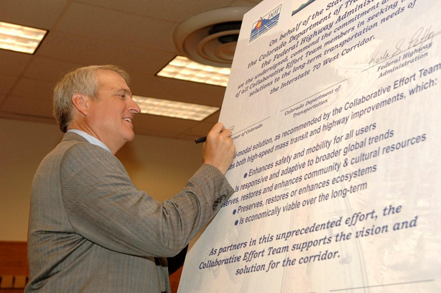A collaborative process to ensure broad stakeholder involvement and consideration of environmental as well as community concerns has proven to be a key element in advancing a suite of multi-modal solutions for the Interstate 70 Mountain Corridor in Colorado.
On March 11, 2011, the Colorado Department of Transportation announced completion of the final Programmatic Environmental Impact Statement (PEIS) for a range of improvements to the 144-mile I-70 Corridor, a vital east-west interstate connection west of Denver and across the Rocky Mountains. This was the agency’s second attempt at a solution for the corridor, after a previous draft environmental document generated public opposition.
The PEIS is a Tier 1 NEPA document that looks at a variety of solutions for the corridor. The preferred alternative – which was developed through wide-ranging stakeholder collaboration – includes a menu of short-term and long-term multi-modal highway and transit solutions to improve transportation through the corridor, while incorporating numerous agreements for consideration of natural resources, wildlife habitat, historic resources, and community concerns.
The preferred alternative identified in the document includes three main elements: non-infrastructure components that can begin in advance of major improvements; an advanced guideway system (AGS) element that is dependent on further study and funding; and a range of highway improvements. The alternative is to be implemented in stages, ranging from a minimum program of local transportation improvements that can be addressed in the shorter term, to a maximum program of improvements – including potential for AGS – to meet projected capacity needs through 2050.
Stakeholder Collaboration
The preferred alternative is the product of years of collaboration among multiple stakeholders working alongside CDOT to identify transportation solutions to address growing congestion and projected future demand for travel along the corridor. It was developed by a group known as the “Collaborative Effort” – including representatives from local governments; highway users; and transit, environmental, business and recreation interests; as well as state and federal agencies.

Colorado Governor Signs Collaborative Agreement. Photo: Colorado DOT
The Collaborative Effort team worked in conjunction with another group of stakeholders who were focused on incorporating CDOT’s commitment to context sensitive solutions as part of the corridor project. As part of that effort, CDOT worked in cooperation with seven counties; 27 towns; two National Forests; one ski corporation; six ski resorts; and thousands of residents, business owners, truckers, and commuters. The group developed a Context Sensitive Solutions Guidance that was used in developing the PEIS and will be followed for all future (Tier 2) projects in the corridor.
The CSS Guidance includes a commitment to form collaborative “Project Leadership Teams” on all corridor projects. For the Corridor PEIS, the Project Leadership Team formed task forces to address cultural resources issues, environmental issues, and community value issues. The task forces developed potential mitigation strategies for impacts to resources for incorporation into the PEIS.
Several memoranda of understanding and agreements were adopted outlining commitments, including:
- A Landscape Level Inventory of Valued Ecosystem Components (ALIVE);
- Stream and Wetland Ecological Enhancement Program (SWEEP); and
- Section 106 Programmatic Agreement for consideration of historic resources.
Comprehensive CSS Guidance Website
The CSS Guidance for the corridor is housed on a comprehensive, interactive website. The site includes a context statement and core values developed by the CSS team, outlines the collaborative decision-making process to be used, and includes background information, maps, plans and legal commitments, as well as additional tools to implement CSS throughout the corridor.
The CSS Guidance also provides design guidelines, including overarching principles as well as more targeted engineering design criteria, areas of special attention, as well as aesthetic guidance to ensure a consistent vision for the corridor projects.
For more information on the CSS process for the corridor, link to the I-70 Mountain Corridor CSS website, and to the PEIS Appendix A, Context Sensitive Solutions. The entire PEIS – including technical reports and appendices – can be downloaded at http://www.coloradodot.info/projects/i-70mountaincorridor/final-peis/final-peis-file-download.html. For additional information on the project, contact CDOT’s I-70 Mountain Corridor Environmental Manager Wendy Wallach at [email protected].

